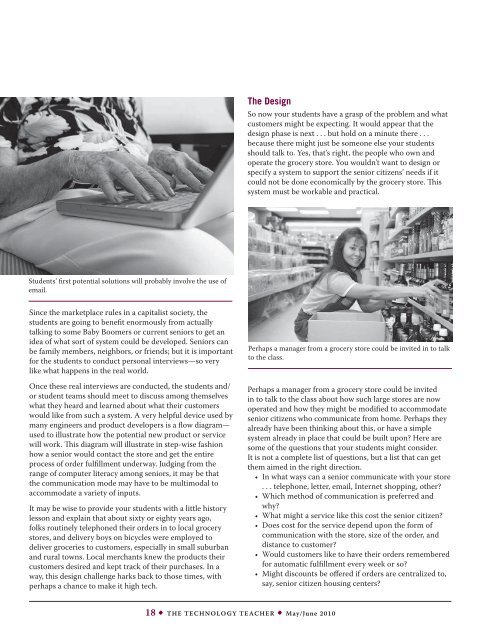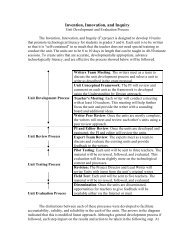May/June - Vol 69, No 8 - International Technology and Engineering ...
May/June - Vol 69, No 8 - International Technology and Engineering ...
May/June - Vol 69, No 8 - International Technology and Engineering ...
Create successful ePaper yourself
Turn your PDF publications into a flip-book with our unique Google optimized e-Paper software.
The Design<br />
So now your students have a grasp of the problem <strong>and</strong> what<br />
customers might be expecting. It would appear that the<br />
design phase is next . . . but hold on a minute there . . .<br />
because there might just be someone else your students<br />
should talk to. Yes, that’s right, the people who own <strong>and</strong><br />
operate the grocery store. You wouldn’t want to design or<br />
specify a system to support the senior citizens’ needs if it<br />
could not be done economically by the grocery store. This<br />
system must be workable <strong>and</strong> practical.<br />
Students’ first potential solutions will probably involve the use of<br />
email.<br />
Since the marketplace rules in a capitalist society, the<br />
students are going to benefit enormously from actually<br />
talking to some Baby Boomers or current seniors to get an<br />
idea of what sort of system could be developed. Seniors can<br />
be family members, neighbors, or friends; but it is important<br />
for the students to conduct personal interviews—so very<br />
like what happens in the real world.<br />
Once these real interviews are conducted, the students <strong>and</strong>/<br />
or student teams should meet to discuss among themselves<br />
what they heard <strong>and</strong> learned about what their customers<br />
would like from such a system. A very helpful device used by<br />
many engineers <strong>and</strong> product developers is a flow diagram—<br />
used to illustrate how the potential new product or service<br />
will work. This diagram will illustrate in step-wise fashion<br />
how a senior would contact the store <strong>and</strong> get the entire<br />
process of order fulfillment underway. Judging from the<br />
range of computer literacy among seniors, it may be that<br />
the communication mode may have to be multimodal to<br />
accommodate a variety of inputs.<br />
It may be wise to provide your students with a little history<br />
lesson <strong>and</strong> explain that about sixty or eighty years ago,<br />
folks routinely telephoned their orders in to local grocery<br />
stores, <strong>and</strong> delivery boys on bicycles were employed to<br />
deliver groceries to customers, especially in small suburban<br />
<strong>and</strong> rural towns. Local merchants knew the products their<br />
customers desired <strong>and</strong> kept track of their purchases. In a<br />
way, this design challenge harks back to those times, with<br />
perhaps a chance to make it high tech.<br />
Perhaps a manager from a grocery store could be invited in to talk<br />
to the class.<br />
Perhaps a manager from a grocery store could be invited<br />
in to talk to the class about how such large stores are now<br />
operated <strong>and</strong> how they might be modified to accommodate<br />
senior citizens who communicate from home. Perhaps they<br />
already have been thinking about this, or have a simple<br />
system already in place that could be built upon? Here are<br />
some of the questions that your students might consider.<br />
It is not a complete list of questions, but a list that can get<br />
them aimed in the right direction.<br />
• In what ways can a senior communicate with your store<br />
. . . telephone, letter, email, Internet shopping, other?<br />
• Which method of communication is preferred <strong>and</strong><br />
why?<br />
• What might a service like this cost the senior citizen?<br />
• Does cost for the service depend upon the form of<br />
communication with the store, size of the order, <strong>and</strong><br />
distance to customer?<br />
• Would customers like to have their orders remembered<br />
for automatic fulfillment every week or so?<br />
• Might discounts be offered if orders are centralized to,<br />
say, senior citizen housing centers?<br />
18 • The <strong>Technology</strong> Teacher • <strong>May</strong>/<strong>June</strong> 2010
















